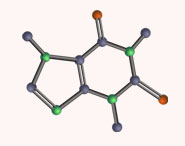


 علم الكيمياء
علم الكيمياء 
 الكيمياء التحليلية
الكيمياء التحليلية 
 الكيمياء الحياتية
الكيمياء الحياتية 
 الكيمياء العضوية
الكيمياء العضوية 
 الكيمياء الفيزيائية
الكيمياء الفيزيائية
 الكيمياء اللاعضوية
الكيمياء اللاعضوية 
 مواضيع اخرى في الكيمياء
مواضيع اخرى في الكيمياء
 الكيمياء الصناعية
الكيمياء الصناعية |
أقرأ أيضاً
التاريخ: 10-7-2018
التاريخ: 20-10-2019
التاريخ: 18-9-2019
التاريخ: 19-9-2018
|
As we pointed out on the previous page, all the cyclic conjugated hydrocarbons have a single lowest energy molecular orbital, and then a stack of degenerate pairs of orbitals of increasing energy. Since the single low energy orbital holds two electrons, and then the successive degen-erate pairs four each, a ‘closed shell’ arrangement in which all the orbitals below a certain level are fi lled will always contain (4n + 2) electrons (where n is an integer—0, 1, 2, etc.—corre-sponding to the number of degenerate orbital pairs). This is the basis of Hückel’s rule.
● Hückel’s rule Planar, fully conjugated, monocyclic systems with (4n + 2) π electrons have a closed shell of electrons all in bonding orbitals and are exceptionally stable. Such systems are said to be aromatic. Analogous systems with 4n π electrons are described as anti-aromatic.
The next (4n + 2) number after six is ten so we might expect this cyclic alkene, [10] annulene, to be aromatic. But if a compound with five cis double bonds were planar, each internal angle would be 144°. Since a normal double bond has bond angles of 120°, this would be far from ideal. This compound can be made but it does not adopt a planar conformation and therefore is not aromatic even though it has ten π electrons.
By contrast, [18] annulene, which is also a (4n + 2) π electron system (n = 4), does adopt a planar conformation and is aromatic. The trans–trans–cis double bond arrangement allows all bond angles to be 120˚. [20] Annulene presumably could become planar (it isn’t quite) but since it is a 4n π electron system rather than a 4n + 2 system, it is not aromatic and the structure shows localized single and double bonds. When the conjugated systems are not monocyclic, the situation becomes a little less clear. Naphthalene, for example, has ten electrons but you can also think of it as two fused benzene rings. From its chemistry, it is very clear that naphthalene has aromatic character (it does substitution reactions) but is less aromatic than benzene itself. For example, naphthalene can easily be reduced to tetralin (1,2,3,4-tetrahydronaphthalene), which still contains a benzene ring. Also, in contrast to benzene, all the bond lengths in naphthalene are not the same. 1,6-Methano [10] annulene is rather like naphthalene but with the middle bond replaced by a methylene bridging group. This compound is almost flat and shows aromatic character.
Hückel’s rule helps us predict and understand the aromatic stability of numerous other systems. Cyclopentadiene, for example, has two conjugated double bonds but the conju gated system is not cyclic since there is an sp3 carbon in the ring. However, this compound is relatively easy to deprotonate to give a very stable anion in which all the bond lengths are the same.
Each of the double bonds contributes two electrons and the negative charge (which must be in a p orbital to complete the conjugation) contributes a further two, making six altogether. The energy level diagram shows that six π electrons completely fill the bonding molecular orbitals, thereby giving a stable aromatic structure.



|
|
|
|
مقاومة الأنسولين.. أعراض خفية ومضاعفات خطيرة
|
|
|
|
|
|
|
عمرها 53 عاما.. رسالة من الحرب الباردة تسقط من السماء
|
|
|
|
|
|
|
العتبة العباسية المقدسة تجري القرعة الخاصة بأداء مناسك الحج لمنتسبيها
|
|
|